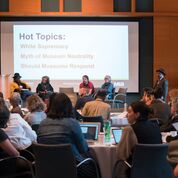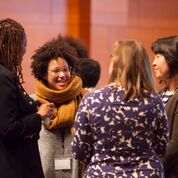How to transform museums into places of greater inclusion and equity? This is the key question of the MASSAction (Museum as Site for Social Action) initiative, begun in 2016 and coordinated out of the Minneapolis Institute of Art.

Panelists address difficult issues raised by participants: white supremacy, museum neutrality, response to current issues. MIA

Participants get to know each other on first day. MIA
A few weeks ago 36 museums (art, history, science) from across the country gathered for the second convening, working through facilitated exercises and a tool kit for museum transformation written by those of us who met in 2016. You can find the entire tool kit and a list of resources here. There is also a Storify and a whole thread of tweets at #MASSActionMIA for October 11-13, 2017. More documentation of the 2017 meeting will be added gradually to this site.
Reflections from the 130 participants are beginning to come in, and below I would like to share the thoughts of Radiah Harper, longtime senior educator, former Vice Director for Education and Program Development at the Brooklyn Museum, and currently head of Radiah Harper Arts and Museum Management Consulting.
25 Ways to See and Act on Decentering Whiteness Aka White Supremacy in the Museum
By Radiah Harper
Hello warriors. Since returning home from the MASS Action convening, I’ve been thinking about the conversations, comments, and action steps we talked about during our time together. It seems to me ‘how to’ touch the humanity of this work, which is our social justice practice, is on folks’ minds. My original intent was to share this piece with the leadership circle from the other day. Today, I’m thinking there are take-aways for all of us.
My goal here is to offer a way in to the question of how to decenter whiteness in the museum. My suggestions are in no way comprehensive, for instance they do not address every colonial issue like stolen cultural patrimony or the economic foundation of the museum. However, I do ask: What self-reflection is necessary to do the work of ending white supremacy in the museum? What skills do we need to build culturally competent relationships and spaces?
Knowing we are the museum, here are 25 ways to check where you are in decentering whiteness or white supremacy.
- If you are not seeing every black, brown, tan, and cream person of color as a person of stature equal to your own, you are not doing the work
- If you are not including the research and perspective of people of color in your work on people of color, you are not doing the work
- If you work with people of color and one person tells you their supervisor is racist and you don’t believe them, you are not doing the work
- If you haven’t addressed racism in the workplace, you are not doing the work
- If you haven’t looked inside yourself to recognize your own biases, you have not begun the work
- If you work with people of color and they quit the job stating the supervisor could not accept the differences between them, you’re not doing the work
- If you are still writing labels about the art, history, and culture of people of color without talking to or researching the perspectives of people of color, you are not doing the work
- If you are not co-creating materials with people of color, you are not doing the work
- If you are not locating where, how and to what degree people of color and white people are interconnected, you are not doing the work
- If you are only recruiting and hiring people of color with education and experience like your own, you are not doing the work
- If the voices of people of color inside and outside the institution are not accepted as true and knowledgeable, you are not doing the work
- If your institutional mission does not include an equity and inclusion statement, you are not doing the work
- If there are no woke people of color on your senior management team, you are not doing the work
- If people of color in the institution are not contributing to idea generation and the implementation of exhibitions and programs, you are not doing the work
- If the images of people of color are not in your brochures and videos or on your website, you are not doing the work
- If images of people of color in states of authority, and not just dancing, are not used in your marketing materials, you are not doing the work
- If the photographer comes to the museum to capture the activities of staff and visitors, and s/he fails to produce photographs of the people of color, you are not doing the work
- If there are no people of color at your fundraiser beside seat fillers, you are not doing the work
- If your acquisitions team or individual curators are finally purchasing objects of black, brown, tan, and cream people and they select the most visually unattractive representation of a person or historical narrative and they say but it references a moment in time and you let that go, you are not doing the work
- If there are no people of color in every facet of your museum then you are not doing the work
- If people of color are not in positions of power throughout your institution then, you are not doing the work
- If people of color are not creating, implementing, and leading without a white gaze hovering, then you are not doing the work
- If you think people of color are angry and you use that to stop progress, you’re not doing the work
- If the white voice has the final word in every situation, then you are not doing the work of decentering whiteness in an institution located within a global society made predominately of people of color.
- If the antidotes to the preceding challenges are not in your consciousness yet, explore them deeply with your colleagues and get to work.
“Let us be those creative dissenters who will call our beloved nation to a higher destiny; to a new plateau of compassion, to a more noble expression of humanness.” ― Dr. Martin Luther King, Jr.
Q. What would you add?
Radiah Harper
October 2017
I would add:
If you are in museum publishing and do not have editorial advisors of color, and/or do not seek out, utilize, and publish work by people of color, you are not doing the work. GJ
How about you? If you are reading this post by email and wish to add a comment please go to www.museumcommons.com or send a tweet @gretchjenn. Thanks.
Pingback: Historical Reminiscents EP 29: Representation and Making Space in Public History – Krista McCracken
Thanks, will check out. G